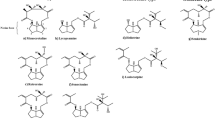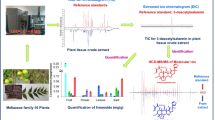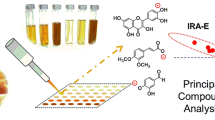Abstract
Alkaloids represent a major group of natural products (NPs), derived from highly diverse organisms. These structurally varied specialized metabolites are widely used for medicinal purposes and also known as toxic contaminants in agriculture and dietary supplements. While the detection of alkaloids is generally facilitated by GC- or LC-MS, these techniques do require considerable efforts in sample preparation and method optimization. Bypassing these limitations and also reducing experimental time, matrix-free laser desorption ionization (LDI) and related methods may provide an interesting alternative. As many alkaloids show close structural similarities to matrices used in matrix-assisted laser desorption ionization (MALDI), they should ionize upon simple laser irradiation without matrix support. With this in mind, the current work presents a systematic evaluation of LDI properties of a wide range of structurally diverse alkaloids. Facilitating a direct comparison between LDI and ESI-MS fragmentation, all tested compounds were further studied by electrospray ionization (ESI). Moreover, crude plant extracts of Atropa belladonna, Cinchona succirubra, and Colchicum autumnale were analyzed by LDI in order to evaluate direct alkaloid detection and dereplication from complex mixtures. Finally, dose-dependent evaluation of MALDI and LDI detection using an extract of Rosmarinus officinalis spiked with atropine, colchicine, or quinine was conducted. Overall, present results suggest that LDI provides a versatile analytical tool for analyzing structurally diverse alkaloids as single compounds and from complex mixtures. It may further serve various potential applications ranging from quality control to the screening for toxic compounds as well as the build up of MS databases.

Graphical abstract






Similar content being viewed by others
References
Vaclavik L, Krynitsky AJ, Rader JI. Targeted analysis of multiple pharmaceuticals, plant toxins and other secondary metabolites in herbal dietary supplements by ultra-high performance liquid chromatography–quadrupole-orbital ion trap mass spectrometry. Anal Chim Acta. 2014;810:45–60.
Fox Ramos AE, Le Pogam P, Fox Alcover C, Otogo N’Nang E, Cauchie G, Hazni H, et al. Collected mass spectrometry data on monoterpene indole alkaloids from natural product chemistry research. Sci Data. déc 2019 [cité 4 avr 2019];6(1). Disponible sur: http://www.nature.com/articles/s41597-019-0028-3.
Otogo N’Nang E, Bernadat G, Mouray E, Kumulungui B, Grellier P, Poupon E, et al. Theionbrunonines A and B: dimeric vobasine alkaloids tethered by a thioether bridge from Mostuea brunonis. Org Lett. 2018;20(20):6596–600.
Alcover CF, Bernadat G, Kabran FA, Le Pogam P, Leblanc K, Fox Ramos AE, et al. Molecular networking reveals serpentinine-related bisindole alkaloids from Picralima nitida, a previously well-investigated species. J Nat Prod. 2020;83(4):1207–16.
Pavarini DP, da Silva DB, Carollo CA, Portella APF, Latansio-Aidar SR, Cavalin PO, et al. Application of MALDI-MS analysis of rainforest chemodiversity: a keystone for biodiversity conservation and sustainable use. J Mass Spectrom. 2012;47(11):1482–5.
Silva R, Lopes N, Silva D. Application of MALDI mass spectrometry in natural products analysis. Planta Med. 2016;82(08):671–89.
Shroff R, Rulíšek L, Doubský J, Svatoš A. Acid–base-driven matrix-assisted mass spectrometry for targeted metabolomics. Proc Natl Acad Sci. 2009;106(25):10092–6.
Law KP, Larkin JR. Recent advances in SALDI-MS techniques and their chemical and bioanalytical applications. Anal Bioanal Chem. 2011;399(8):2597–622.
Ernst M, Silva DB, Silva RR, Vêncio RZ, Lopes NP. Mass spectrometry in plant metabolomics strategies: from analytical platforms to data acquisition and processing. Nat Prod Rep. 2014;31(6):784–806.
Kudaka I, Asakawa D, Mori K, Hiraoka K. A comparison of EDI with solvent-free MALDI and LDI for the analysis of organic pigments. J Mass Spectrom. 2008;43(4):436–46.
Le Pogam P, Schinkovitz A, Legouin B, Le Lamer A-C, Boustie J, Richomme P. Matrix-free UV-laser desorption ionization mass spectrometry as a versatile approach for accelerating dereplication studies on lichens. Anal Chem. 2015;87(20):10421–8.
Le Pogam P, Boustie J, Richomme P, Denis A, Schinkovitz A. The inherent matrix properties of lichen metabolites in matrix-assisted laser desorption ionization time-of-flight mass spectrometry. Rapid Commun Mass Spectrom. 2017;31(23):1993–2002.
Schinkovitz A, Boisard S, Freuze I, Osuga J, Mehlmer N, Brück T, et al. Matrix-free laser desorption ionization mass spectrometry as a functional tool for the analysis and differentiation of complex phenolic mixtures in propolis: a new approach to quality control. Anal Bioanal Chem. 2018;410(24):6187–95.
Rogers K, Milnes J, Gormally J. The laser desorption/laser ionization mass spectra of some indole derivatives and alkaloids. Int J Mass Spectrom Ion Process. 1992;115(2–3):219–33.
Rogers K, Milnes J, Gormally J. The laser desorption/laser ionization mass spectra of some methylated xanthines and the laser desorption of caffeine and theophylline from thin layer chromatography plates. Int J Mass Spectrom Ion Process. 1993;123(2):125–31.
Skopikova M, Hashimoto M, Richomme P, Schinkovitz A. Matrix-free laser desorption ionization mass spectrometry as an efficient tool for the rapid detection of opiates in crude extracts of Papaver somniferum. J Agric Food Chem. 2019;68(3):884–91.
Ibáñez AJ, Scharte J, Bones P, Pirkl A, Meldau S, Baldwin IT, et al. Rapid metabolic profiling of Nicotiana tabacum defence responses against Phytophthora nicotianae using direct infrared laser desorption ionization mass spectrometry and principal component analysis. Plant Methods. 2010;6(1):14.
Nonami H, Fukui S, Erra-Balsells R. β-Carboline alkaloids as matrices for matrix-assisted ultraviolet laser desorption time-of-flight mass spectrometry of proteins and sulfated oligosaccharides: a comparative study using phenylcarbonyl compounds, carbazoles and classical matrices. J Mass Spectrom. 1997;32(3):287–96.
Vermillion-Salsbury RL, Hercules DM. 9-Aminoacridine as a matrix for negative mode matrix-assisted laser desorption/ionization. Rapid Commun Mass Spectrom. 2002;16(16):1575–81.
Rosinke B, Strupat K, Hillenkamp F, Rosenbusch J, Dencher N, Krüger U, et al. Matrix-assisted laser desorption/ionization mass spectrometry (MALDI-MS) of membrane proteins and non-covalent complexes. J Mass Spectrom. 1995;30(10):1462–8.
Wang M, Carver JJ, Phelan VV, Sanchez LM, Garg N, Peng Y, et al. Sharing and community curation of mass spectrometry data with Global Natural Products Social Molecular Networking. Nat Biotechnol. 2016;34(8):828.
Jaber A, Seraphin D, Guilet D, Osuga J, Cheble E, Ibrahim G, et al. Bithiophenic MALDI matrices as valuable leads for the selective detection of alkaloids. Anal Bioanal Chem. 409(29):6791–801.
Belladona leaf. In: European Pharmacopoeia 95. European Directorate for the Quality of Medicines and Healthcare. 2018. p. 4452–3.
Quinquina. In: European Pharmacopoeia 92. European Directorate for the Quality of Medicines and Healthcare. 2018. p. 4742–3.
Bruguière A, Derbré S, Dietsch J, Leguy J, Rahier V, Pottier Q, et al. MixONat, a software for the dereplication of mixtures based on 13C NMR spectroscopy. Anal Chem. 2020;92:8793–801.
Strohalm M, Kavan D, Novak P, Volny M, Havlicek V. mMass 3: a cross-platform software environment for precise analysis of mass spectrometric data. Anal Chem. 2010;82(11):4648–51.
Wiegelmann M, Soltwisch J, Jaskolla TW, Dreisewerd K. Matching the laser wavelength to the absorption properties of matrices increases the ion yield in UV-MALDI mass spectrometry. Anal Bioanal Chem. 2013;405(22):6925–32.
Karas M, Bachmann D, Hillenkamp F. Influence of the wavelength in high-irradiance ultraviolet laser desorption mass spectrometry of organic molecules. Anal Chem. 1985;57(14):2935–9.
Horneffer V, Dreisewerd K, Lüdemann H-C, Hillenkamp F, Läge M, Strupat K. Is the incorporation of analytes into matrix crystals a prerequisite for matrix-assisted laser desorption/ionization mass spectrometry? A study of five positional isomers of dihydroxybenzoic acid. Int J Mass Spectrom. 1999;185:859–70.
Chen X, Carroll JA, Beavis RC. Near-ultraviolet-induced matrix-assisted laser desorption/ionization as a function of wavelength. J Am Soc Mass Spectrom. 1998;9(9):885–91.
Dreisewerd K. The desorption process in MALDI. Chem Rev. 2003;103(2):395–426.
Wu KJ, Steding A, Becker CH. Matrix-assisted laser desorption time-of-flight mass spectrometry of oligonucleotides using 3-hydroxypicolinic acid as an ultraviolet-sensitive matrix. Rapid Commun Mass Spectrom. 1993;7(2):142–6.
Zenobi R, Knochenmuss R. Ion formation in MALDI mass spectrometry. Mass Spectrom Rev. 1998;17(5):337–66.
Gomes CMR, Gottlieb OR. Alkaloid evolution and angiosperm systematics. Biochem Syst Ecol. 1980;8(1):81–7.
Crescentini TM, Stow SM, Forsythe JG, May JC, McLean JA, Hercules DM. Structural characterization of methylenedianiline regioisomers by ion mobility-mass spectrometry and tandem mass spectrometry. 4. 3-ring and 4-ring isomers. Anal Chem. 2018;90(24):14453–61.
Schinkovitz A, Kenfack GT, Levillain E, Dias M, Helesbeux J-J, Derbré S, et al. Free and immobilized matrix molecules: impairing ionization by quenching secondary ion formation in laser desorption MS. J Mass Spectrom. 2011;46(9):884–90.
Ohashi M, Wilson JM, Budzikiewicz H, Shamma M, Slusarchyk WA, Djerassi C. Mass spectrometry in structural and stereochemical problems. XXXI. Aporphines and related alkaloids. J Am Chem Soc. 1963;85(18):2807–10.
Castedo L, López S, De Lera AR, Villaverde C. Alkaloids of Sarcocapnos crassifolia subsp. speciosa. Phytochemistry. 1989;28(1):251–7.
Guinaudeau H, Freyer AJ, Shamma M. Spectral characteristics of the bisbenzylisoquinoline alkaloids. Nat Prod Rep. 1986;3:477.
Jeong E-K, Lee SY, Yu SM, Park NH, Lee H-S, Yim Y-H, et al. Identification of structurally diverse alkaloids in Corydalis species by liquid chromatography/electrospray ionization tandem mass spectrometry. Rapid Commun Mass Spectrom. 2012;26(15):1661–74.
Shariatgorji M, Spacil Z, Maddalo G, Cardenas LB, Ilag LL. Matrix-free thin-layer chromatography/laser desorption ionization mass spectrometry for facile separation and identification of medicinal alkaloids. Rapid Commun Mass Spectrom. 2009;23(23):3655–60.
Deroussent A, Ré M, Hoellinger H, Vanquelef E, Duval O, Sonnier M, et al. In vitro metabolism of ethoxidine by human CYP1A1 and rat microsomes: identification of metabolites by high-performance liquid chromatography combined with electrospray tandem mass spectrometry and accurate mass measurements by time-of-flight mass spectrometry. Rapid Commun Mass Spectrom. 2004;18(4):474–82.
Messmer WM, Tin-wa M, Fong HHS, Bevelle C, Farnsworth NR, Abraham DJ, et al. Fagaronine, a new tumor inhibitor isolated from Fagara zanthoxyloides Lam. (Rutaceae). J Pharm Sci. 1972;61(11):1858–9.
Dostál J, Bochořáková H, Táborská E, Slavík J, Potáček M, Buděšínský M, et al. Structure of sbanguinarine ase. J Nat Prod. 1996;59(6):599–602.
Qing Z-X, Cheng P, Liu X-B, Liu Y-S, Zeng J-G. Systematic identification of alkaloids in Macleaya microcarpa fruits by liquid chromatography tandem mass spectrometry combined with the isoquinoline alkaloids biosynthetic pathway. J Pharm Biomed Anal. 2015;103:26–34.
Thiel A, Etheve S, Fabian E, Leeman WR, Plautz JR. Using in vitro/in silico data for consumer safety assessment of feed flavoring additives – a feasibility study using piperine. Regul Toxicol Pharmacol. 2015;73(1):73–84.
Verpoorte R, Niessen WMA. Liquid chromatography coupled with mass spectrometry in the analysis of alkaloids. Phytochem Anal. 1994;5(5):217–32.
Bowden K. Acidity functions for strongly basic solutions. Chem Rev. 1966;66(2):119–31.
Witkop B. Gelsemine. J Am Chem Soc. 1948;70(4):1424–7.
Bartlett MF, Dickel DF, Taylor WI. The alkaloids of Tabernanthe iboga. Part IV. 1 The structures of ibogamine, ibogaine, tabernanthine and voacangine. J Am Chem Soc. 1958;80(1):126–36.
Weiming C, Yaping V, Xiaotian L. Alkaloids from roots of Alstonia yunnanensis. Planta Med. 1983;49:62.
Schirmer R. Reserpine. Anal Profiles Drug Subst. 1975;4:384–430.
Douglas KT, Sharma RK, Walmsley JF, Hider RC. Ionization processes of some harmala alkaloids. Mol Pharmacol. 1983;23(3):614–8.
Dou X, Yao W, Jiang C, Lu Y. Enantioselective N-alkylation of isatins and synthesis of chiral N-alkylated indoles. Chem Commun. 2014;50(77):11354–7.
Scott WG, Horan LH, Martick M. The hammerhead ribozyme: structure, catalysis, and gene regulation. In: Progress in molecular biology and translational science. Elsevier; 2013. p. 1–23.
von Bruchhausen F, Ebel S, Hackenthal E, Holzgrabe U. Hagers Handbuch der Pharmazeutischen Praxis: Folgeband 5: Stoffe LZ. Springer-Verlag; 2013. S 853–855.
Wilson JM, Ohashi M, Budzikiewicz H, Šantavỳ F, Djerassi C. Mass spectrometry in structural and stereochemical problems—XXXIII: colchicine alkaloids. Tetrahedron. 1963;19(12):2225–31.
Zhang P, Li Y, Liu G, Sun X, Zhou Y, Deng X, et al. Simultaneous determination of atropine, scopolamine, and anisodamine from Hyoscyamus niger L. in rat plasma by high-performance liquid chromatography with tandem mass spectrometry and its application to a pharmacokinetics study. J Sep Sci. 2014;37(19):2664–74.
Hölscher D, Shroff R, Knop K, Gottschaldt M, Crecelius A, Schneider B, et al. Matrix-free UV-laser desorption/ionization (LDI) mass spectrometric imaging at the single-cell level: distribution of secondary metabolites of Arabidopsis thaliana and Hypericum species: matrix-free UV-LDI mass spectrometric imaging at the single-cell level. Plant J. 2009;60(5):907–18.
Silva DB, Turatti ICC, Gouveia DR, Ernst M, Teixeira SP, Lopes NP. Mass spectrometry of flavonoid vicenin-2, based sunlight barriers in Lychnophora species. Sci Rep. 2014;4:4309.
Le Pogam P, Legouin B, Geairon A, Rogniaux H, Lohézic-Le Dévéhat F, Obermayer W, et al. Spatial mapping of lichen specialized metabolites using LDI-MSI: chemical ecology issues for Ophioparma ventosa. Sci Rep. 2016;6:37807.
Acknowledgments
Mass spectrometric experiments were performed at the MATRIX platform of the University of Angers.
Author information
Authors and Affiliations
Corresponding authors
Ethics declarations
Conflict of interest
The authors declare that they have no conflict of interest.
Additional information
Publisher’s note
Springer Nature remains neutral with regard to jurisdictional claims in published maps and institutional affiliations.
Electronic supplementary material
ESM 1
(PDF 18996 kb)
Rights and permissions
About this article
Cite this article
Le Pogam, P., Richomme, P., Beniddir, M.A. et al. A thorough evaluation of matrix-free laser desorption ionization on structurally diverse alkaloids and their direct detection in plant extracts. Anal Bioanal Chem 412, 7405–7416 (2020). https://doi.org/10.1007/s00216-020-02872-6
Received:
Revised:
Accepted:
Published:
Issue Date:
DOI: https://doi.org/10.1007/s00216-020-02872-6




